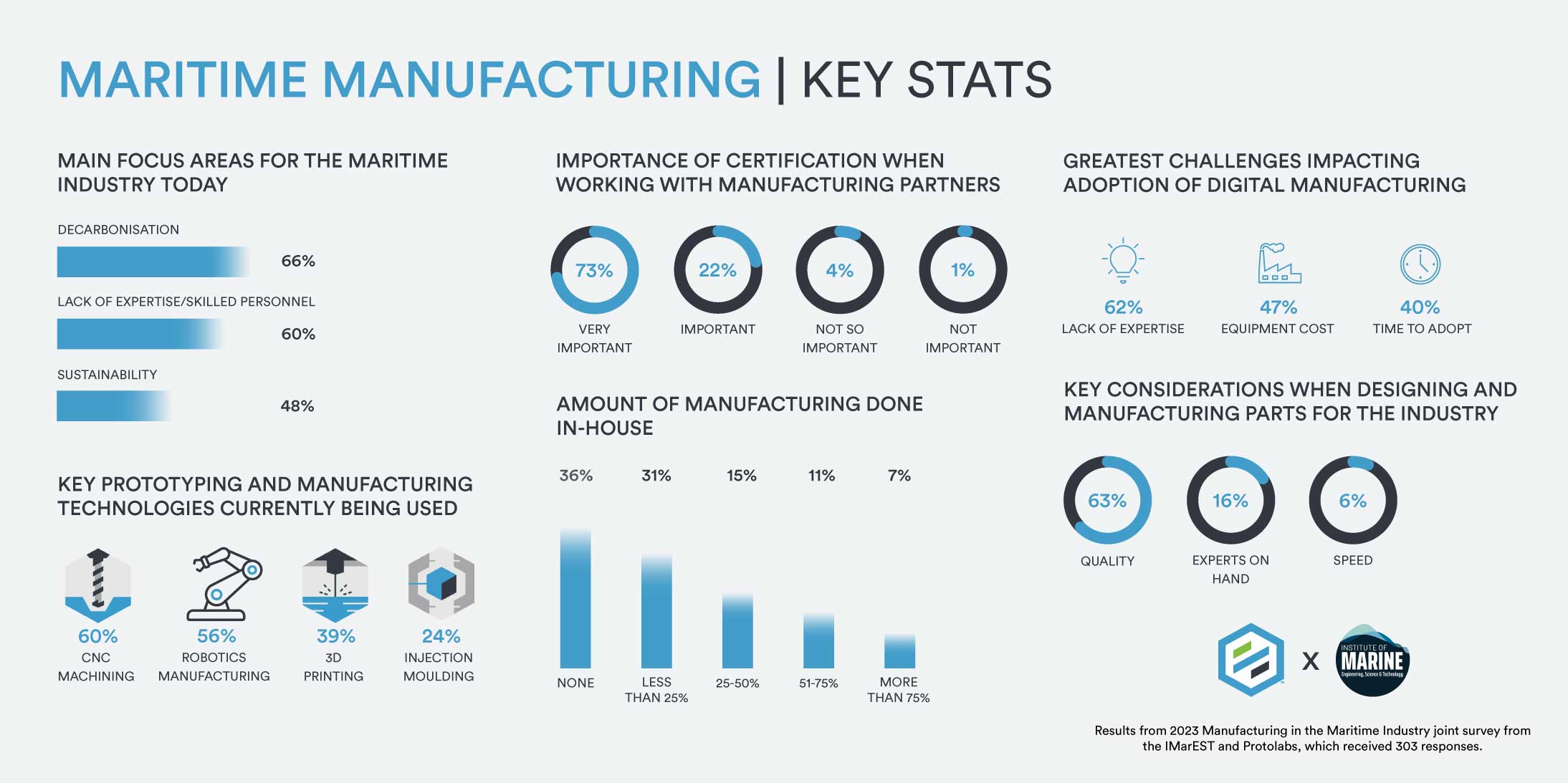The world is heating up – and heating up quickly. The start of summer in 2023 brought heatwaves across the northern hemisphere, fuelling wildfires and threatening lives. From Rhodes to Russia, China to California, people sweltered in record-breaking temperatures. Global average sea surface temperatures reached “unprecedented levels” in June, according to the EU’s Copernicus Climate Change Service, with “exceptionally warm sea surface temperatures” in the North Atlantic.
It was perhaps no surprise, then, that decarbonisation was front and foremost in response to a new survey by the IMarEST and Protolabs. Two-thirds (66.2%) of the 303 respondents said it was the main challenge facing the maritime industry, up 1.2% compared to last year’s survey. Sustainability was also seen as more important this year, up 2.7% to 48%.
“Unfortunately, total decarbonisation is very unlikely,” one respondent said. “As a discipline, the maritime sector will be the example of reducing as low as practical [while] keeping it profitable.”
Another said that full decarbonisation is still a way away. “Nuclear energy is going to be the game changer,” they claimed, “so the future opportunities are lying in research and development in using nuclear energy as an alternate fuel for shipping.”
The survey, focused on manufacturing trends in the marine industry, received responses from all corners of the globe, and a huge variety of professions – everyone from students and research scientists to naval architects and fleet managers.
A lack of expertise and skilled personnel – which last year tied with decarbonisation as the biggest challenge for the maritime industry – dropped to second place at 60.6%, suggesting that some successful steps are being introduced to tackle the problem.
The fuel supply chain was selected as a main industry challenge by a quarter of people who took part (24.8%), down 5.5% compared to last year, reflecting the drop in fuel prices after highs linked to the Russian invasion of Ukraine.
Building momentum

Layer by layer, 3D printing is on the rise. More than a third of respondents (38.7%) said it was a key manufacturing technology for the maritime sector, up 6.6% on last year.
It was also seen as a promising area for further development, with many people saying it will be a major future opportunity for the maritime sector. Several suggested that on-board printers could provide replacement components or bespoke, customised parts for specific applications on vessels.
In future, workers will download designs, print them, and replace parts “immediately”, one respondent said, “optimising the supply chain and reducing downtime, in turn improving efficiency”.
Another said there will be a “significant opportunity to utilise 3D printing technology. When implemented correctly, it has the potential to save both time and money. High design flexibility, which means lots of structure optimisation can be made.”
They added: “However, one main concern that arises is the fatigue sensitivity of 3D-printed structures and how it impacts the design process. It is crucial to carefully consider and address these fatiguerelated challenges.”
Manufacturing change

As 3D printing increases in stature, CNC machining might be on the wane – although it is still by far the most important manufacturing technology used in maritime, picked by two-thirds of respondents (60.6%), down 6.5% on last year. Robotic manufacturing was second (56%), down 5.5%.
This year’s survey found that the vast majority of manufacturing is still not done in-house – only 7.6% of respondents said more than three-quarters of their manufacturing is done in-house, and 10.6% said half to threequarters is in-house.
More than a third (36.1%) said none of their manufacturing is inhouse, down from 44.1% last year.
When asked to pick the top three requirements for a supplier, replies were nearly unanimous: quality came out on top, selected by 86.5%; price was second (57.4%); and certification was third (48.5%).
Certification is absolutely key when working with manufacturing partners, respondents said. Almost three-quarters (72.9%) said it is “very important”, while a further 22.9% said it is “quite important”.
Low expertise

Automation within maritime manufacturing remains low, with more than two-thirds of
respondents saying either “none” (35.1%) or “under 25%” (35.4%) of their company’s manufacturing services are automated. Only 7.6% of respondents said that more than half of their manufacturing services are automated. The number of respondents with no automation fell slightly, however, from 40.7% last year.
Lack of expertise is far and away the biggest challenge facing the adoption of digital manufacturing techniques in maritime, said the respondents, 62% of whom picked it as their main concern, up 8.2% on last year.
Equipment cost (46.4%) and time to adopt (40.4%) were the second and third greatest challenges, followed by a lack of awareness and lack of training, both at 38.4%.
Autonomous advance
While automation in manufacturing makes slow progress, respondents were optimistic about increased use of artificial intelligence and related technologies, which they said could lead to greater autonomy in control, navigation and other areas.
“The advancement of autonomous vessels and remote operating technology has the potential to transform the maritime industry. This opens up
prospects for better efficiency, cost savings, and improved safety in transportation and marine operations,” one person said.
“Digital twins” of ships will help reduce operation and maintenance costs, another respondent said, with big data bringing “enormous advantages”. They added: “Bringing a global maritime sector connected to the internet will improve logistics significantly. For this, digital twin models of the operational environment will be needed.”
Alternative fuels, tidal and floating wind energy, robotic construction, carbon capture and other nascent technologies were all also picked as major future opportunities for the sector. Despite the challenges ahead, there could be a bright future as these novel technologies mature.







